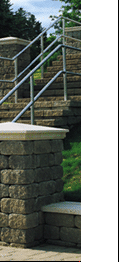|

 |
|
Below is a brief summary of installation steps with video
clips. If you are building a VERSA-LOK® Retaining Wall
System and would like a copy of our FREE Design &
Installation Guide for either our Standard or Mosaic®
systems, you can download it now
in Adobe Acrobat® format. For technical assistance, call
1.800.770.4525.
The
installation steps below are for VERSA-LOK Standard Retaining
Wall Systems ONLY. For information on installing VERSA-LOK
Mosaic Retaining Wall Systems, please download the Mosaic
Design & Installation Guide above.
Important:
Walls that support heavy loads or exceed four feet in height
require special soil reinforcement and often professionally
engineered designs. Please consult a qualified engineer if
unsure about any construction, site or soil conditions. Also
be sure to check local building codes before wall construction
or design.
If
you do not have Quicktime on your computer, click here
to download a free player.
|
 |

 |
Step
1
Leveling Pad Preparation
VERSA-LOK walls should be placed on a leveling pad of
well-compacted gravel, crushed stone or coarse sand approximately
6" thick and 24" wide. The first course of VERSA-LOK units
should be embedded below grade approximately 1/10th of
the exposed wall height. Excavate to lines and grades
you've established for your wall, allowing for the leveling
pad and unit embedment. Place and compact leveling pad
material. It may be helpful to add a thin layer of sand
to create a uniform, level pad.
|
 |
Step
2
Install
Base Course
Place
VERSA-LOK units on prepared leveling pad. As you proceed,
level each unit front to back, side to side, and with adjacent
units. Leveling is critical at this stage, so take your
time! Align straight wall sections using a string line or
by sighting down the grooves on unit tops. If your wall
has a corner, begin at the corner and work out from there.
|
 |
Step
3
Drainage
aggregate and backfill
First, place drainage aggregate (3/4-inch clear, free-draining,
angular gravel) between and directly behind units at a minimum
thickness of 12 inches. Drainage aggregate keeps water pressure
from building up behind the face of the wall. Next, place
soil backfill directly behind drainage aggregate in layers
no thicker than six inches. Compact the backfill, making
sure it is neither too wet nor too dry. Generally, hand-operated
vibratory-plate compactors can be used to achieve adequate
compaction of granular soils - even on larger projects.
|
 |
Step
4
Install
Successive Courses
Stack
units one course at a time. Set units back 3/4" and insert
two VERSA-TUFF pins per unit in front holes of units so
they fall into the rear slots of the units beneath. Tap
pins with another pin and a mallet to properly set them.
Place and compact drainage aggregate behind each course
as it is completed.
|
|
Step
5
Geosynthetic soil reinforcement
If your wall is higher than four feet or shoulders significant
loads, you will need to install geosynthetic soil reinforcement.
As each course is laid, place soil reinforcement horizontally
on top of compacted backfill and VERSA-LOK units. Geosynthetic
layers should be placed about one inch from the front of
VERSA-LOK units. Keep in mind, geosynthetics are usually
stronger in one direction. For correct orientation, follow
the geosynthetic manufacturer's directions carefully.
|
 |
Step
6
Install
Caps
After
completing the top course of your wall, install VERSA-LOK
caps, either with a slight overhang (recommended), set back
or flush with the wall face. Use VERSA-LOK concrete adhesive
to secure cap units to the wall.
|
|
|
 |



![]()
![]()